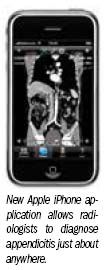iPhone enables fast diagnosis of appendicitis
If you want to diagnose appendicitis, there's an app for that.
If you want to diagnose appendicitis, there's an app for that.
Radiologists may soon be able to use an Apple iPhone application to view CT images wherever there's a wireless connection.
The study, performed at the University of Virginia in Charlottesville and presented at RSNA 2009, found that 15 of 25 patients referred to CT scanning for right lower quadrant abdominal pain were correctly diagnosed with acute appendicitis on 74 of 75 interpretations, with only one false negative and no false positives. In eight of the 15 patients who had appendicitis, 88% of interpretations correctly identified calcified deposits in the appendix.
“The iPhone interpretations of the CT scans were as accurate as the interpretations viewed on dedicated PACS workstations,” said Dr. Asim F. Choudhri, a neuroradiology fellow at Johns Hopkins University, during an RSNA news conference.
The iPhone application may be most useful to residents or trainees who need immediate faculty feedback on complicated cases.

While e-mail messages of single images have been used in the past, OsiriX Mobile allows imagers to scroll through a full data set, he said.
On new iPhones, which utilize the 3G network, data streaming can be as fast as three seconds per image-or only one second per image when logged into a wireless broadband network. But patient privacy issues still need to be addressed before such applications can achieve widespread use in clinical practice, Choudhri said. The iPhones utilized in the study were kept in a locked location, but password, virtual private network, or firewall protection may also be employed to protect patient privacy.
Since the general public can also download OsiriX Mobile, the application may enable patients to more easily access their own images.
“This can allow patients to be a part of their healthcare process,” Dr. Choudhri said.
The Reading Room Podcast: Current Perspectives on the Updated Appropriate Use Criteria for Brain PET
March 18th 2025In a new podcast, Satoshi Minoshima, M.D., Ph.D., and James Williams, Ph.D., share their insights on the recently updated appropriate use criteria for amyloid PET and tau PET in patients with mild cognitive impairment.
Meta-Analysis Shows Merits of AI with CTA Detection of Coronary Artery Stenosis and Calcified Plaque
April 16th 2025Artificial intelligence demonstrated higher AUC, sensitivity, and specificity than radiologists for detecting coronary artery stenosis > 50 percent on computed tomography angiography (CTA), according to a new 17-study meta-analysis.